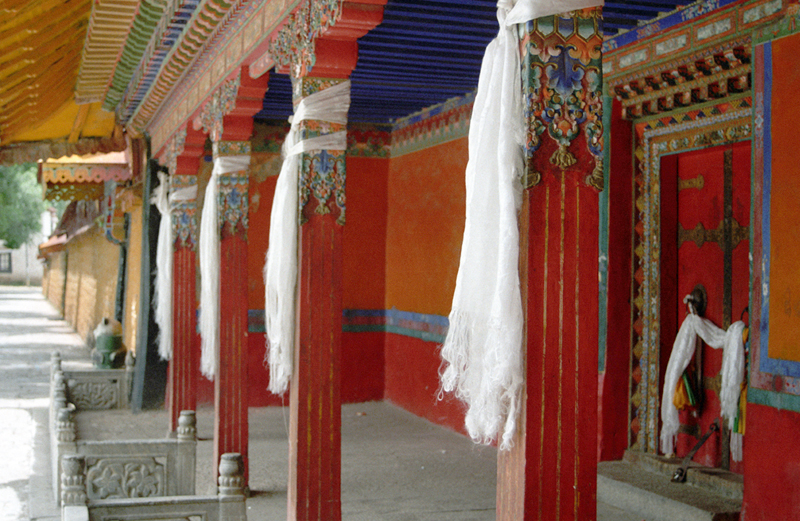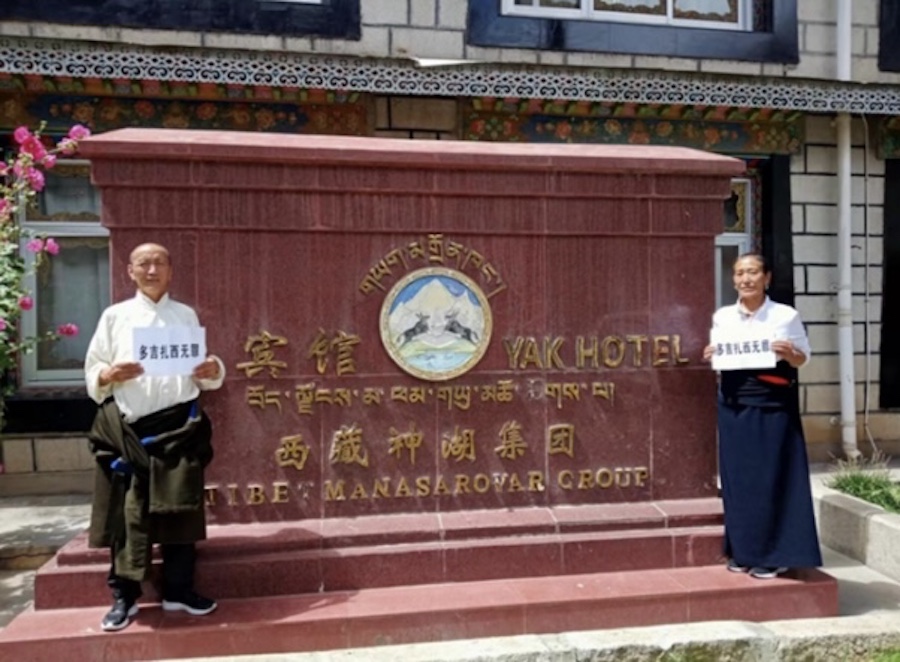By Vijay Kranti
(Part of the ‘My journey through the Tibetan mindscape’ series)
For the people who have had ever watched anti-China demonstrations of Tibetan refugees and their supporters across the world, the very first shock inside ‘China’s Tibet’ is near total absence of anti-China anger among the local Tibetan masses. Along the crowded peripheral path around the holy Jokhang temple in Lhasa or, for that matter, any local temple in a smaller town, one is surprised at the peace and calm visible on the faces of Tibetans who are circumambulating the temple holding their rosary or rotating their personal prayer wheels. Soon you discover that this peace is deceptive.
Despite your own initiative at starting a dialogue, very rarely the local Tibetans would look at you in your eyes or exchange words with you. The reason is simple. They are aware of the hundreds of prying close circuit TV cameras mounted on every wall, pole or a roof top which can land them into serious trouble for talking to a foreigner. In the streets too, if you come into eye contact with an individual Tibetan, more chances are that you will just get a short kind smile before that person returns to his/her usual indifferent self. At very rare places and moments where a Tibetan is sure that he or she is not being watched by a camera or a PSB agent that you can expect a comfortable smile and a measured curiosity. (PSB i.e. Public Security Bureau, is the dreaded ‘Gestapo’ of Chinese Communist government who is more omnipresent in Today’s Tibet than God Himself.)
But that does not mean that the Tibetan subjects of this Chinese colony don’t speak up against the colonial occupation of their country or they are resigned to their fate. In a country where keeping a photo of the exiled Dalai Lama is a guaranteed invitation for a seven-year jail term, speaking for the freedom of Tibet or against the Chinese masters is bound to invite unfathomable physical torture in addition to a jail term which could even mean a full life term in jail. Over the years the skill of expressing opposition to China’s presence in Tibet has acquired the status of a superbly encrypted public language, rather a fine art.
As I frequently point out, the late 10th Panchen Lama has emerged as the most prominent symbol of Tibetan resistance in today’s Tibet. For the Beijing regime he was a suitable collaborator whereas for ordinary Tibetans he died as a true hero for speaking up fearlessly against the true nature of Chinese rule over Tibet. At almost every conceivable place his large posters and framed photos simply outplay the Beijing sponsored ‘Gyaltsen Norbu’ whom the CPC has thrust upon the Tibetan masses as the ‘real’ 11th Panchen Lama, but without much success over past 25 years.
The only place where I could see the Chinese sponsored Panchen Lama’s picture during my first encounter with today’s Tibet, was inside Tashi Lhumpo monastery — the official central seat of Panchen Lamas. But there too, one cannot miss how the Tibetan devotees merely play a lip service and almost bypass his seat and picture. The only other time when I saw the Chinese sponsored Panchen Lama’s picture was in the room of a young Tibetan monk in one of the most celebrated monasteries which I visited during a later visit. I was shocked to see a crumpled post card sized picture of the Beijing sponsored ‘Panchen Lama’ sharing space in a corner of his room where the young monk had stored his used soap, tooth brush and shoe polish. With a contemptuous naughty smile, he told me, “I place it at the altar only when my room is due for inspection by the Chinese officials.”
An outstanding common feature in most of the temples and monasteries inside Tibet is the presence of a nicely decorated, but empty seat at the most central place of a main hall. There is no photo or a name sticker on this seat but everyone knows beyond doubt to whom does this seat belong. The presence of a large heap of Khatas (ceremonial scarves) offered reverentially in their full flowing length, and an impressive pile of currency notes would tell you that it’s the Dalai Lama’s seat – omnipresent in absentia. And just to repel any remaining doubts one will find this seat occupying a higher place than the presiding Lama of that monastery or the temple.
Inside the Norbulingka, the summer palace of Dalai Lama, where he resided until the fateful night of his escape to India in March 1959, this reverence is expressed a bit too openly. In addition to his personal seat, bed and other personal furniture which Chinese government has put up on display as a mark of their ‘victory’ over Tibet, even the bath tub, attached to Dalai Lama’s personal room, remains filled with scarves and currency notes. This heap of money explains why the local communist bosses don’t mind this public expression of people’s love for a Dalai Lama whom none in the past three generations has ever seen. One also can’t miss long scarves tied around wooden pillars around the Norbulingka. If you can manage to ask a Tibetan about the purpose of tying the Khatas, good chances are that you are told that it is expression of their wish to see Dalai Lama back in his Norbulingka palace.
But the most aesthetic, and assertive too, expression of this desire of ordinary Tibetan people to see Dalai Lama back in Tibet was at the Drepung monastery of Lhasa. It is one among the three main national monasteries namely Depung, Sera and Ganden. At the entrance of a main temple hall I was surprised to see that the central part of the stone laid stair case was fully occupied by a nicely placed heap of Khatas in the middle and a planter placed at both ends of the central set of stairs. In a normal public place like this, where a good number of tourists and pilgrims were to enter and leave every day, one would expect the local management to keep the stairs hurdle free and open. It took me some time and efforts to find an answer to this interesting riddle. As an old tradition in Tibet, the central part of the main staircase to a major temple is always kept reserved for the Dalai Lama. On special occasions and celebrations, the presiding lama of the monastery too can have used the central stairs. In this case the real challenge before the local devotees and the managers was to keep these stairs free from the shoes and feet of tourists and to preserve its sanctity till the day the Dalai Lama returns to Tibet and visits this monastery. That’s why the Khatas and the planters.
During my next visit some years later, I discovered that this wait for the return of Dalai Lama was still going on — as aesthetically and as assertively.
(Views expressed are his own)
The author is a senior Indian journalist, photographer and a keen Tibet watcher for over four decades. He visited Tibet many times on his self assigned learning and photo-expeditions. He was the first ever Indian journalist who could visit Tibet without Chinese patronization or control. Here is the latest in his series of his memoirs with Tibet and Tibetan people.











3 Responses
Its Time for The Dalai Lama to come home,
The world is now a different place,
Its Time for The Dalai Lama to come home.
Vijay Ji,
You have come out with another blockbuster of your experience in the Roof of World. Conclusion is that no matter how hard the CCP tries, it will NEVER EVER SUCCEED in alienating the Tibetan people with His Holiness. More than 150 sacrificed their lives ( through self immolation) in the last few years due to their frustration of not being heard by the outside world of the Chinese continued atrocities. Believe it or not, majority of these freedom fighters have never seen His Holiness. Such is our faith and conviction in His Holiness.
Thank you once again !
Expecting for more BLOCKBUSTERS !!!!
Vijay! Victory. Thanks for supporting Tibetan people through thick and thin. Tibet will remember you! Thog je che